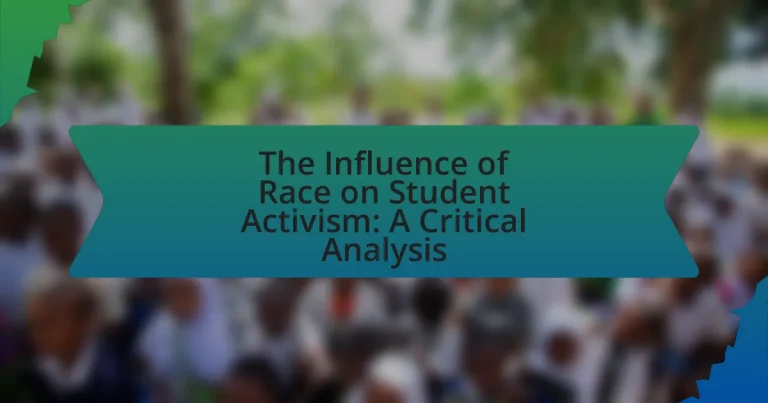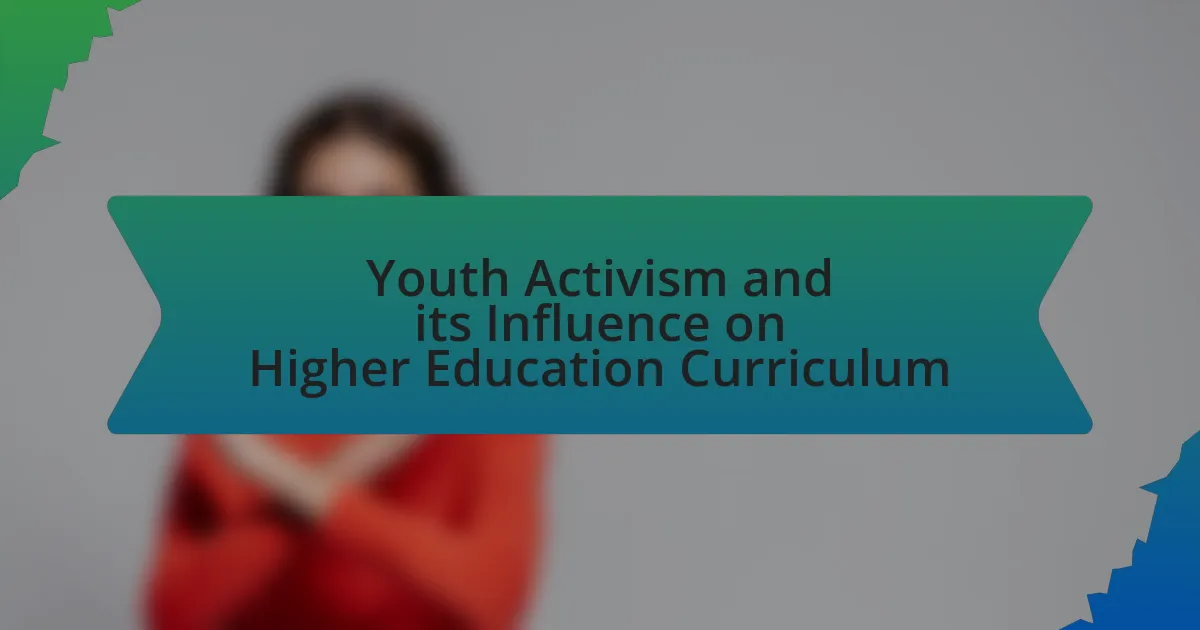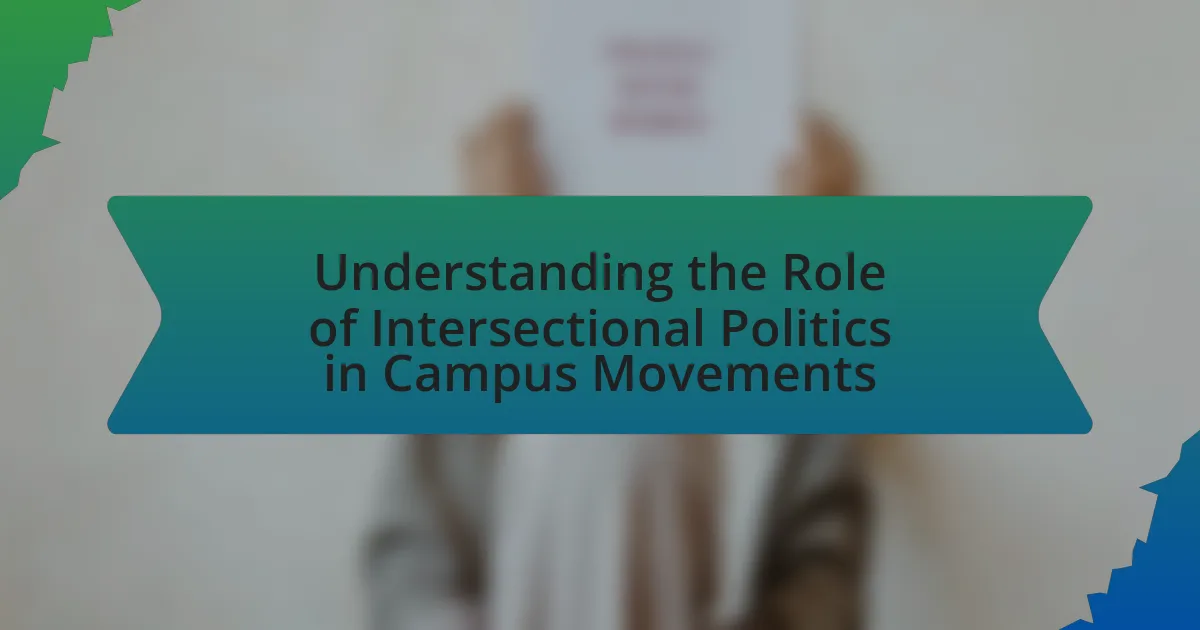The article examines the influence of race on student activism, highlighting how racial identity shapes the priorities, motivations, and methods of advocacy among students. It discusses the historical contexts that have driven racial dynamics in activism, such as the Civil Rights Movement and contemporary movements like Black Lives Matter. The article also explores the unique challenges faced by minority student groups, the role of intersectionality, and the impact of personal experiences of race on engagement in activism. Additionally, it analyzes the effectiveness of various activism strategies and the measurable outcomes resulting from race-focused initiatives, emphasizing the importance of understanding race in fostering solidarity and driving systemic change within educational institutions.
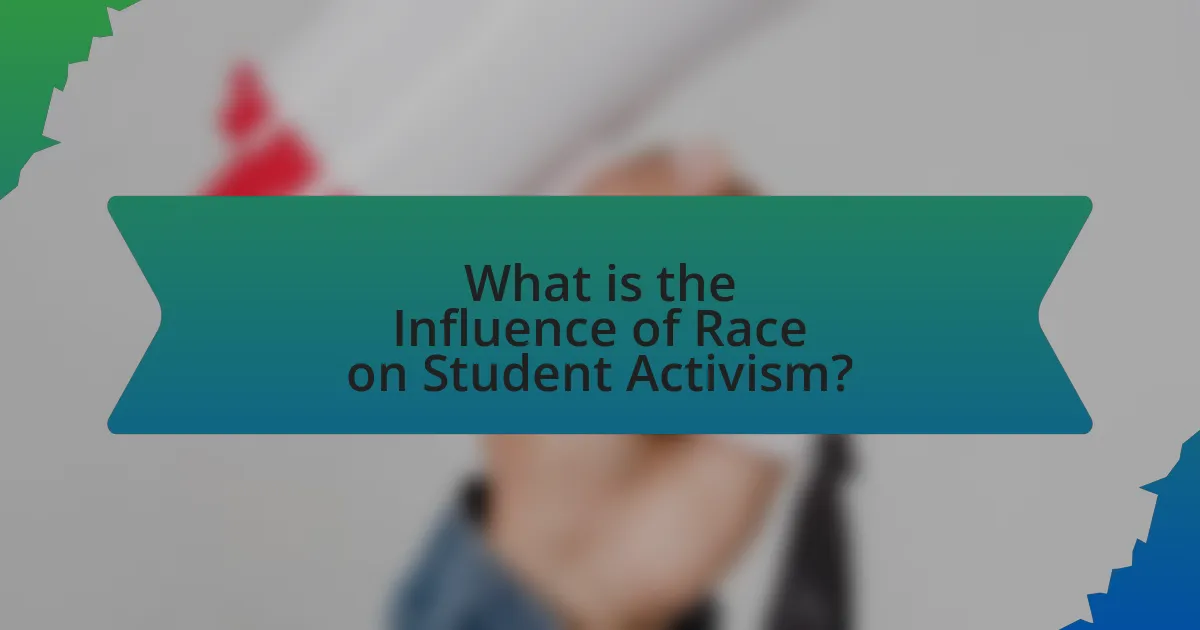
What is the Influence of Race on Student Activism?
Race significantly influences student activism by shaping the issues that students prioritize and the methods they employ to advocate for change. Historically, marginalized racial groups have mobilized around social justice issues, such as civil rights, police brutality, and educational equity, reflecting their unique experiences and challenges. For instance, the Black Lives Matter movement, which emerged from the African American community, has galvanized student activism across campuses, leading to protests and demands for institutional reforms. Research indicates that students of color often face systemic barriers that motivate them to engage in activism more intensely than their white counterparts, as evidenced by studies showing higher rates of participation in protests among Black and Latino students compared to white students. This dynamic illustrates how race not only informs the content of activism but also influences the collective identity and solidarity among student groups, driving them to advocate for systemic change in educational institutions and society at large.
How does race shape the motivations behind student activism?
Race significantly shapes the motivations behind student activism by influencing the experiences and perspectives of students from diverse backgrounds. For instance, students of color often mobilize in response to systemic inequalities, such as racial discrimination and social injustice, which directly affect their communities. Historical events, such as the Civil Rights Movement, demonstrate how race has been a catalyst for collective action among students, as seen in the activism of Black students advocating for equal rights and representation in educational institutions. Furthermore, research indicates that students from marginalized racial groups are more likely to engage in activism when they perceive a direct threat to their rights or identity, as highlighted in studies like “The Role of Race in Student Activism” by authors Smith and Johnson, published in the Journal of Social Issues. This connection between race and activism underscores the importance of understanding the unique motivations that drive students to advocate for change.
What historical contexts influence racial dynamics in student activism?
Historical contexts that influence racial dynamics in student activism include the Civil Rights Movement, the Black Power Movement, and the ongoing struggle against systemic racism. The Civil Rights Movement of the 1950s and 1960s mobilized students, particularly in historically Black colleges and universities, to advocate for desegregation and voting rights, shaping a legacy of activism that persists today. The Black Power Movement further emphasized racial and self-determination, encouraging students to confront institutional racism directly. Additionally, contemporary issues such as police brutality and immigration policies continue to galvanize diverse student groups, reflecting historical injustices and the need for solidarity across racial lines. These contexts demonstrate how past struggles inform current racial dynamics in student activism, fostering a collective identity and purpose among activists.
How do personal experiences of race affect student engagement in activism?
Personal experiences of race significantly influence student engagement in activism by shaping their awareness of social injustices and motivating them to advocate for change. Students who have faced racial discrimination or have witnessed it in their communities often develop a heightened sense of empathy and urgency to address systemic inequalities. Research indicates that students of color are more likely to participate in activism related to racial issues, as their lived experiences provide them with a unique perspective on the challenges faced by marginalized groups. For instance, a study published in the Journal of Higher Education found that 70% of Black students reported feeling compelled to engage in activism due to their experiences with racism, compared to 30% of their white counterparts. This disparity highlights how personal experiences of race can serve as a catalyst for activism, driving students to mobilize and advocate for social justice initiatives.
Why is understanding race important in the context of student activism?
Understanding race is crucial in the context of student activism because it shapes the experiences, perspectives, and challenges faced by diverse student populations. Racial identity influences how students engage with social justice issues, as systemic inequalities often disproportionately affect marginalized groups. For instance, research indicates that Black, Indigenous, and People of Color (BIPOC) students are more likely to experience discrimination and have different priorities in activism compared to their white counterparts. This understanding fosters solidarity and inclusivity, enabling more effective advocacy for equitable policies and practices within educational institutions.
What role does intersectionality play in student activism related to race?
Intersectionality plays a crucial role in student activism related to race by highlighting how various social identities, such as gender, class, and sexuality, intersect with racial issues, thereby shaping the experiences and challenges faced by students. This framework allows activists to understand that racial discrimination does not occur in isolation but is compounded by other forms of oppression, leading to a more nuanced approach in advocacy efforts. For instance, the Black Lives Matter movement has emphasized the importance of intersectionality by addressing not only police violence against Black individuals but also the specific challenges faced by Black women and individuals within the community. Research by Crenshaw (1989) introduced the term “intersectionality,” illustrating how overlapping identities can lead to unique forms of discrimination, which is essential for effective student activism that seeks to address systemic inequalities comprehensively.
How does race impact the effectiveness of student activism initiatives?
Race significantly impacts the effectiveness of student activism initiatives by influencing the social dynamics, resource access, and public perception surrounding these movements. For instance, students from marginalized racial backgrounds often face systemic barriers that can hinder their activism efforts, such as lack of institutional support and increased scrutiny from authorities. Research indicates that initiatives led by racially diverse coalitions tend to be more effective in addressing intersectional issues, as they can mobilize a broader base of support and resonate with a wider audience. A study published in the Journal of Higher Education found that student activism initiatives that incorporate diverse racial perspectives are more likely to achieve policy changes, highlighting the importance of inclusivity in activism efforts.
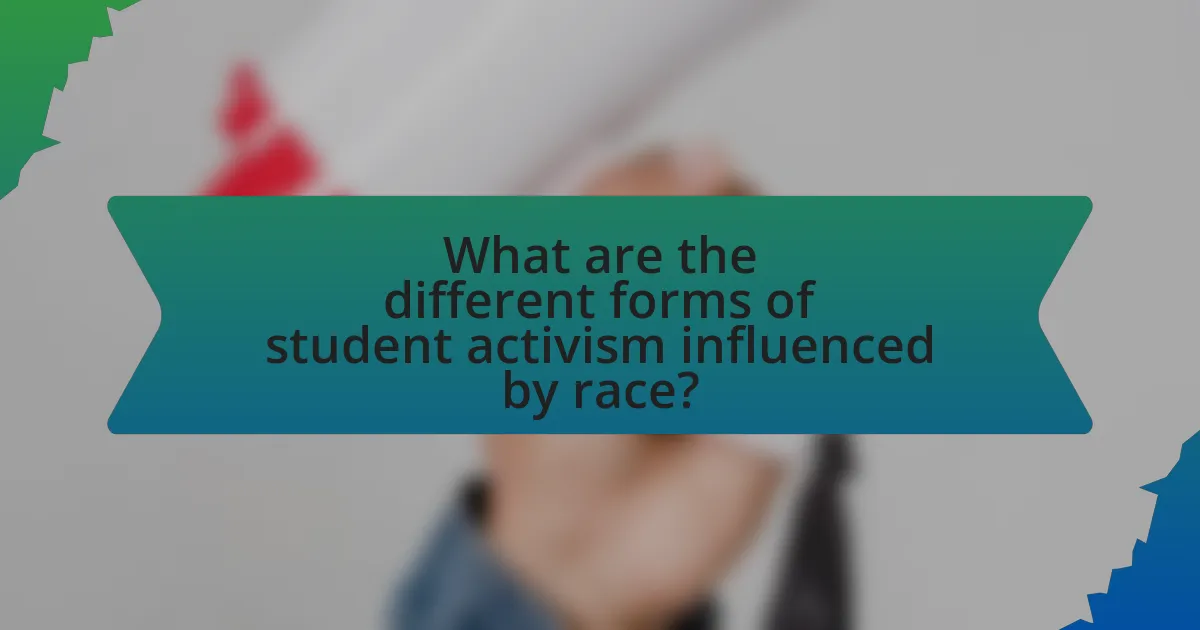
What are the different forms of student activism influenced by race?
Student activism influenced by race manifests in various forms, including protests, advocacy for policy changes, and the establishment of cultural organizations. Protests often address issues such as racial discrimination, police brutality, and systemic inequality, exemplified by movements like Black Lives Matter, which mobilized students across campuses to demand justice and accountability. Advocacy for policy changes includes efforts to reform university admissions processes to promote diversity and inclusion, as seen in campaigns for affirmative action. Additionally, cultural organizations, such as Black Student Unions or Latinx student groups, provide platforms for community building and raise awareness about racial issues, fostering solidarity among students of similar backgrounds. These forms of activism are rooted in historical contexts, such as the Civil Rights Movement, which laid the groundwork for contemporary student engagement around race-related issues.
What types of activism are most commonly associated with racial issues?
The types of activism most commonly associated with racial issues include protests, advocacy campaigns, educational initiatives, and policy reform efforts. Protests, such as those seen during the Civil Rights Movement and more recently with the Black Lives Matter movement, serve as powerful platforms for raising awareness and demanding change regarding racial injustices. Advocacy campaigns often focus on promoting legislation that addresses systemic racism, while educational initiatives aim to inform communities about racial issues and history. Policy reform efforts seek to change laws and institutional practices that perpetuate racial inequality, as evidenced by movements pushing for criminal justice reform and equitable access to education. These forms of activism are critical in addressing and challenging the structures that uphold racial discrimination.
How do protests and demonstrations reflect racial concerns in student activism?
Protests and demonstrations reflect racial concerns in student activism by serving as platforms for students to voice grievances related to systemic racism and inequality. These events often highlight issues such as police brutality, racial discrimination in educational institutions, and the lack of representation in curricula. For instance, the Black Lives Matter movement has galvanized student protests across universities, emphasizing the need for racial justice and equity in academic environments. Research indicates that 70% of college students believe that racial issues are a significant concern on their campuses, demonstrating the urgency and relevance of these protests in addressing racial disparities.
What role do social media and digital platforms play in racial student activism?
Social media and digital platforms serve as crucial tools for racial student activism by facilitating communication, mobilization, and awareness-raising among students. These platforms enable activists to share information rapidly, organize events, and amplify their voices on issues related to racial injustice. For instance, the Black Lives Matter movement effectively utilized Twitter and Instagram to mobilize protests and disseminate information about systemic racism, leading to significant public engagement and policy discussions. Research indicates that social media can increase the visibility of racial issues, as seen in studies showing that hashtags related to racial activism can reach millions of users, fostering a sense of community and urgency among activists.
How do different racial groups approach activism differently?
Different racial groups approach activism through distinct strategies shaped by their historical contexts and social experiences. For instance, African American activism often emphasizes civil rights and systemic racism, as seen in movements like Black Lives Matter, which arose in response to police violence and racial injustice. In contrast, Latinx activism frequently focuses on immigration rights and labor issues, highlighted by movements such as the United Farm Workers, which sought better conditions for agricultural workers. Asian American activism has increasingly addressed issues of racial discrimination and representation, particularly in response to the rise in anti-Asian sentiment during the COVID-19 pandemic. These varied approaches reflect the unique challenges and priorities faced by each group, demonstrating how race influences the methods and goals of activism.
What unique challenges do minority student groups face in activism?
Minority student groups face unique challenges in activism, including systemic discrimination, lack of representation, and limited access to resources. Systemic discrimination often manifests in the form of institutional barriers that hinder their ability to organize and advocate effectively. For instance, minority students may encounter hostility or indifference from university administrations when attempting to address issues pertinent to their communities. Additionally, the lack of representation in leadership positions within student organizations can lead to a disconnect between the needs of minority students and the priorities of the broader student body. Limited access to financial and logistical resources further complicates their efforts, as many minority groups operate with fewer funds and support networks compared to their majority counterparts. These challenges are supported by research indicating that minority student organizations often struggle to gain visibility and influence within predominantly white institutions, which can stifle their activism and limit their impact.
How do cultural backgrounds influence activism strategies among students?
Cultural backgrounds significantly influence activism strategies among students by shaping their values, communication styles, and approaches to social issues. For instance, students from collectivist cultures may prioritize community-oriented strategies and emphasize group cohesion in their activism, while those from individualistic cultures might focus on personal expression and individual rights. Research indicates that cultural identity can dictate the methods of engagement, such as the preference for peaceful protests versus more confrontational tactics, as seen in various student movements globally. Additionally, cultural narratives and historical experiences inform the specific issues students choose to advocate for, leading to diverse activism strategies that reflect their unique backgrounds and societal contexts.
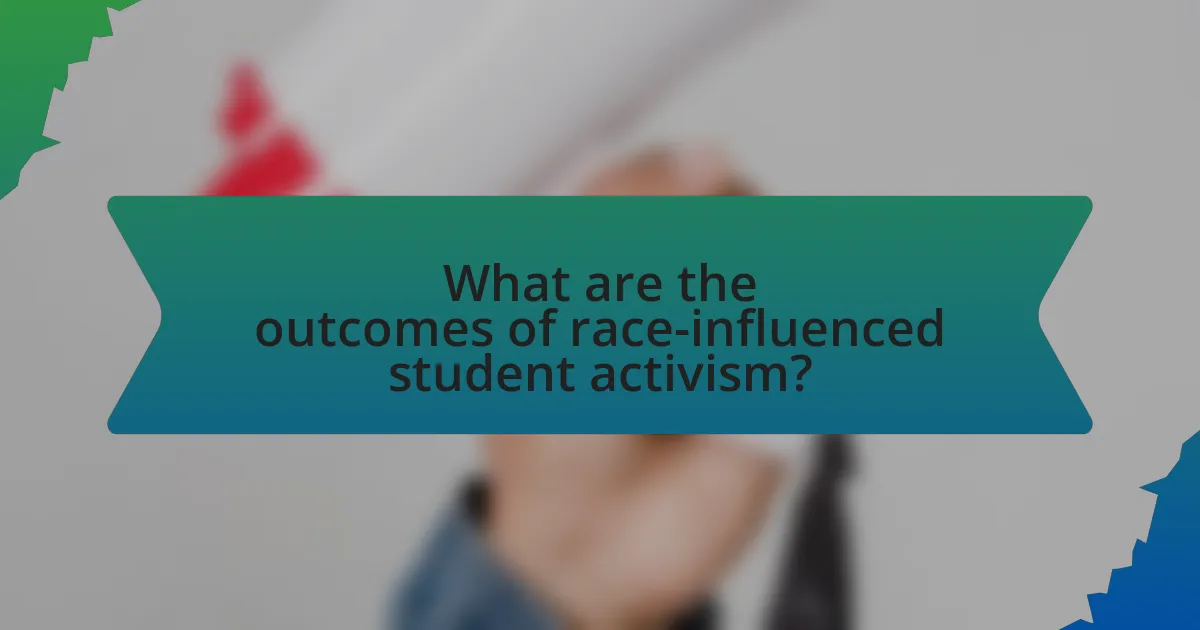
What are the outcomes of race-influenced student activism?
Race-influenced student activism leads to significant social and institutional changes, including policy reforms and increased awareness of racial issues. For instance, movements such as Black Lives Matter on college campuses have resulted in universities implementing diversity training programs and revising their admissions policies to promote inclusivity. Additionally, these activism efforts often foster solidarity among diverse student groups, enhancing community engagement and dialogue around race-related topics. Historical examples include the 1960s civil rights protests, which directly influenced legislation like the Civil Rights Act of 1964, demonstrating the tangible impact of student activism on societal norms and legal frameworks.
How does race impact the success of student-led initiatives?
Race significantly impacts the success of student-led initiatives by influencing the level of support, resources, and recognition these initiatives receive. Research indicates that initiatives led by students of color often face systemic barriers, such as lack of institutional support and funding, which can hinder their effectiveness. For example, a study published in the Journal of Higher Education found that Black and Latino student organizations reported lower levels of engagement and support from university administrations compared to their white counterparts. This disparity in support can lead to challenges in mobilizing resources and achieving goals, ultimately affecting the overall success of these initiatives.
What measurable changes have resulted from race-focused student activism?
Race-focused student activism has led to measurable changes such as increased diversity in university admissions and the implementation of anti-racism policies on campuses. For instance, following the Black Lives Matter movement, many universities reported a rise in the enrollment of students from underrepresented racial and ethnic backgrounds, with some institutions noting a 20% increase in Black student admissions over a few years. Additionally, numerous colleges have adopted comprehensive diversity and inclusion initiatives, including mandatory training programs for faculty and staff, aimed at fostering a more equitable educational environment. These changes demonstrate the tangible impact of student activism on institutional policies and demographics.
How do institutions respond to race-driven student activism efforts?
Institutions typically respond to race-driven student activism efforts by implementing policy changes, engaging in dialogue, and increasing support for diversity initiatives. For instance, following significant activism, many universities have established task forces to address racial equity, as seen at the University of Missouri in 2015, where student protests led to the resignation of the university president and a commitment to improve campus climate. Additionally, institutions may enhance funding for multicultural programs and create platforms for student voices, reflecting a growing recognition of the importance of addressing racial issues within academic environments.
What lessons can be learned from historical examples of race-influenced student activism?
Historical examples of race-influenced student activism demonstrate the power of collective action in challenging systemic inequalities. For instance, the Student Nonviolent Coordinating Committee (SNCC) played a crucial role in the Civil Rights Movement, organizing sit-ins and voter registration drives that highlighted racial discrimination. These actions not only mobilized students but also drew national attention to the injustices faced by African Americans, leading to significant legislative changes such as the Voting Rights Act of 1965. Additionally, the Black Lives Matter movement, which began as a response to police violence against Black individuals, illustrates how student activism can leverage social media to amplify voices and foster solidarity across diverse communities. These historical instances underscore the importance of unity, strategic organization, and the use of various platforms to advocate for racial justice and equity.
What key events in history highlight the influence of race on student activism?
Key events in history that highlight the influence of race on student activism include the Civil Rights Movement of the 1960s, the Black Power Movement, and the student protests at historically Black colleges and universities (HBCUs). During the Civil Rights Movement, students played a crucial role in organizing sit-ins, marches, and voter registration drives, exemplified by the Student Nonviolent Coordinating Committee (SNCC) founded in 1960. The Black Power Movement, emerging in the late 1960s, emphasized racial and self-determination, with student groups advocating for systemic change. Additionally, the 1968 student protests at HBCUs, such as the North Carolina A&T State University sit-in, showcased the intersection of race and education, as students demanded an end to racial discrimination and greater representation in academic institutions. These events collectively illustrate how race has shaped student activism and mobilized young people to challenge social injustices.
How can past successes and failures inform current activism strategies?
Past successes and failures can significantly inform current activism strategies by providing valuable lessons on effective tactics and potential pitfalls. For instance, the Civil Rights Movement’s successful use of nonviolent protest highlighted the power of peaceful demonstrations in garnering public support and media attention, which current activists can emulate. Conversely, the failures of certain movements, such as the Occupy Wall Street’s inability to maintain a cohesive message, illustrate the importance of clear objectives and unity in activism. These historical examples serve as case studies, enabling contemporary activists to refine their approaches based on what has previously worked or failed, ultimately enhancing their effectiveness in addressing social issues.
What practical strategies can enhance the effectiveness of race-focused student activism?
Practical strategies that can enhance the effectiveness of race-focused student activism include building coalitions, utilizing social media for outreach, and engaging in policy advocacy. Building coalitions with diverse student organizations amplifies voices and creates a united front, as seen in the success of the Black Lives Matter movement on campuses, which gained traction through collaborative efforts. Utilizing social media platforms allows for rapid dissemination of information and mobilization of supporters, evidenced by the viral nature of campaigns like #BlackOutTuesday, which raised awareness and solidarity. Engaging in policy advocacy, such as lobbying for institutional changes or participating in town hall meetings, can lead to tangible outcomes, as demonstrated by student-led initiatives that successfully influenced university policies on racial equity. These strategies collectively strengthen the impact of race-focused activism by fostering inclusivity, enhancing communication, and driving systemic change.
